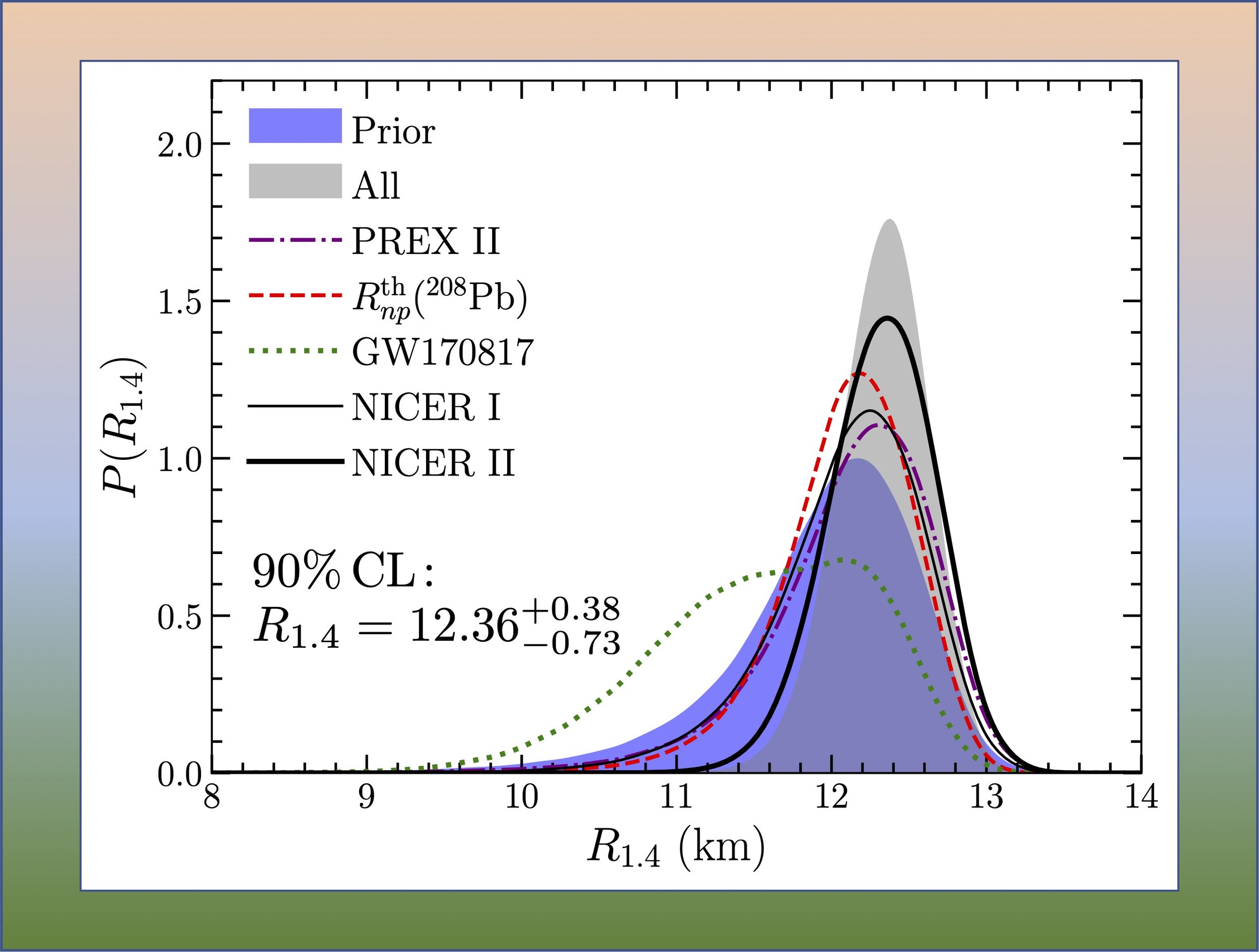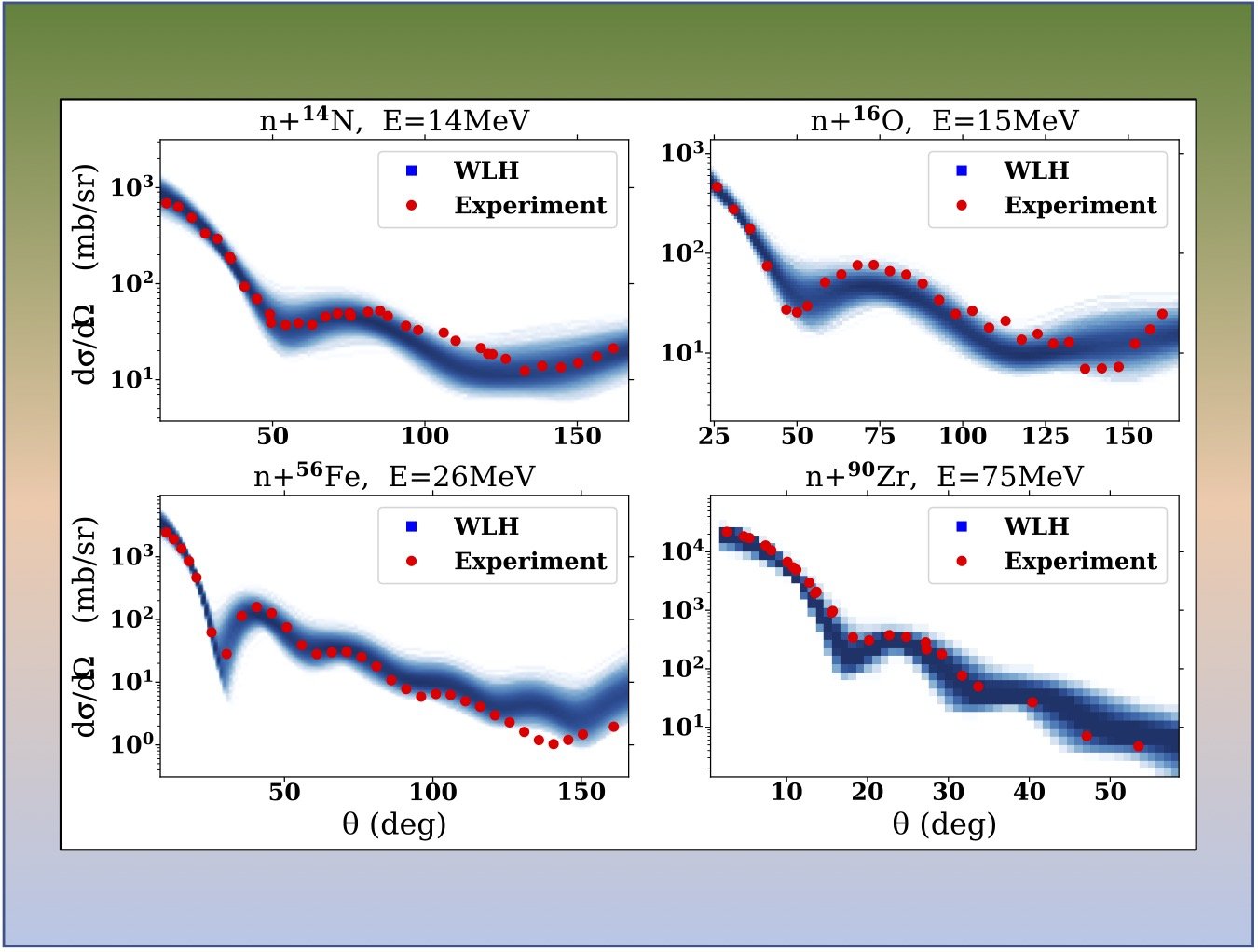Research Highlights
Nucleon-nucleon scattering phase shifts as a function of lab energy calculated from nuclear forces across a continuum of resolution scales Λ.
Machine learning the nucleon-nucleon interaction
The nuclear potential arises from quantum chromodynamics (QCD) as the low-energy effective interaction among composite nucleons. This gives rise to an inherent uncertainty due to the choice of resolution scale at which nuclear dynamics is resolved. In this work, we show that generative machine learning models can be trained on a set of existing nuclear potentials and then generate novel instances of the nuclear force across a continuum of resolution scales.
Inverse electron-neutrino (blue) and antineutrino (red) mean free paths in beta-equilibrium nuclear matter including nuclear mean fields and RPA correlations.
Neutrino interactions in hot and dense matter
In core-collapse supernovae and neutron star mergers, neutrino-nucleon scattering and absorption cross sections are modified by the presence of nuclear mean fields and correlations. Nuclear mean fields are known to enhance neutrino absorption and suppress antineutrino absorption outside of newly born neutron stars, and in the present work we show that nuclear correlations computed within the random phase approximation (RPA) generically have the opposite effect and can be equal or larger in magnitude than mean field effects. We conjecture that such effects may reduce r-process nucleosynthesis and enhance neutrino energy deposition to aid the supernova explosion mechanism.
Probability distribution for the radius of a 1.4 solar-mass neutron star. The prior distribution is shown as the blue band, while the individual effect of various likelihood functions are shown as lines. The complete posterior including all likelihood functions is shown as the gray band.
Neutron star bulk properties
Understanding the nature of neutron star inner cores, which contain the densest observable matter in the universe, remains a longstanding theoretical and observational challenge. In this work, we combine recent constraints from (1) ab initio calculations of the nuclear matter equation of state, (2) nuclear experiments for the neutron skin thickness of 208Pb, and (3) neutron star observations to predict values of neutron star radii, moments of inertia, and tidal deformabilities. Our hope is that future neutron star observations will reveal deviations from our models, which may indicate the presence of exotic matter in neutron star inner cores.
π− and π+ rapidity distributions from theoretical transport simulations (lines) and experiment (symbols) for Au-Au collisions at different centralities: 0%−10%(blue), 10%−20% (green), 20%−30% (orange), 30%−40% (red).
Equation of state from laboratory heavy-ion collisions
The high-density behavior of the nuclear equation of state can be probed in intermediate-energy heavy-ion collisions in the lab. In particular, the ratio of charged pions (π+/π−) produced in these collisions has the potential to illuminate the highly uncertain isovector properties of hot and dense nuclear matter that are needed to better model supernovae and neutron star mergers. In this work, we confront pion production in Au+Au collisions at √sₙₙ = 2.4 GeV with transport simulations using the relativistic Vlasov-Uehling-Uhlenbeck (RVUU) model. By introducing a medium dependence to the ∆-resonance production cross section, we find overall good agreement with rapidity distributions of π+ and π− mesons.
Top: Comparing the total relative uncertainty in the calculation of the nuclear equation of state as a function of accumulated samples (5000 samples/iteration) for normalizing flow importance sampling and VEGAS importance sampling. Bottom: Same as top except for the batch relative uncertainty with 5000 samples/batch.
Machine learning for quantum many-body calculations
Numerical simulations of core-collapse supernovae and neutron star mergers require the nuclear equation of state evaluated at over 1,000,000 phase space points across the relevant densities, temperatures, and compositions probed in the simulations. Here we show that a new class of machine learning models (“normalizing flows”) can open the door to much more efficient quantum many-body calculations of the nuclear equation of state employing fundamental nuclear two-body and three-body forces. Our results are benchmarked against a state-of-the-art computational method (VEGAS).
Neutron differential elastic scattering cross sections from the microscopic global optical potential with quantified uncertainties (blue) compared to experimental data (red dots).
Microscopic nuclear scattering and reactions
Neutron-capture rates on exotic, neutron-rich isotopes are particularly important for r-process nucleosynthesis, where novel elements are created following a series of rapid, successive neutron captures. However, these reactions can be difficult or impossible to directly measure in the laboratory. In this work, we develop new microscopic models of nucleon-nucleus potentials grounded in fundamental two- and three-body forces that may have greater predictive power for radioactive isotopes. The theoretical predictions (with uncertainty estimates) for nucleon-nucleus elastic scattering were found to be in very good agreement with experiment for isotopes near stability where they could be tested.





